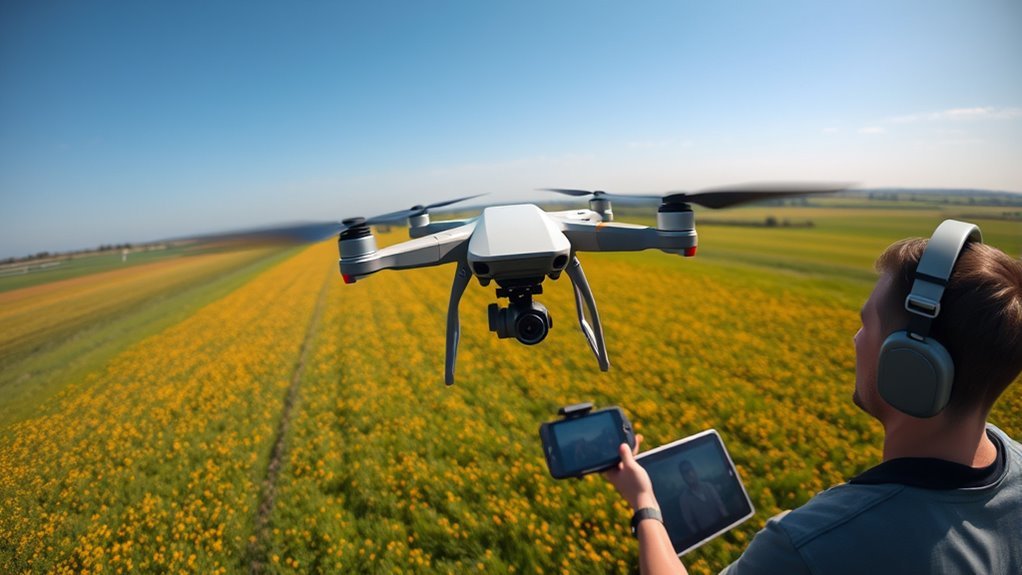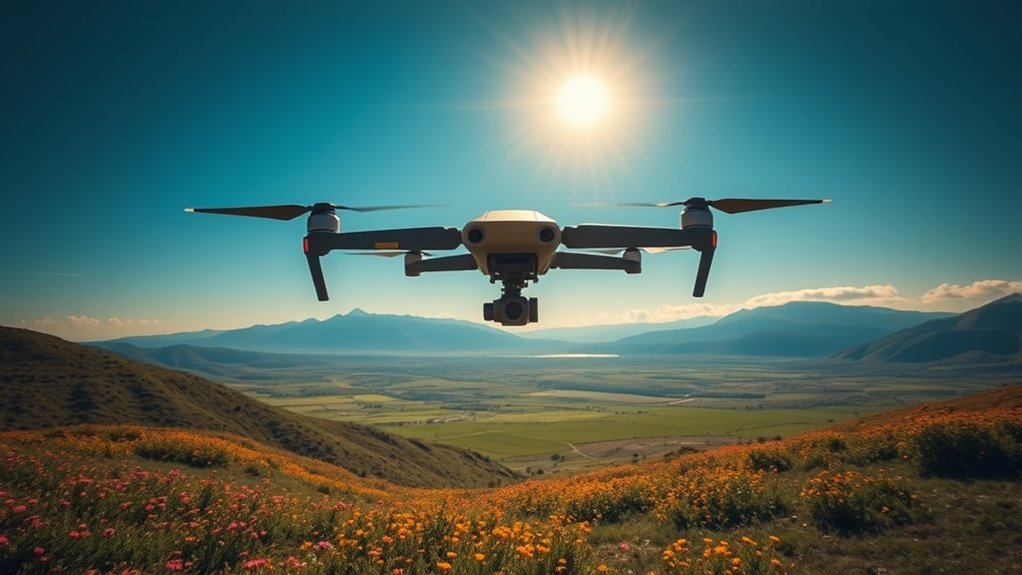If you want to become a drone pilot, you’ll need to understand regulations, get the right certifications, and hone essential flight skills. Familiarity with airspace rules and safety protocols is vital for safe operations. Choosing the right drone is equally important, considering features like camera quality and battery life. Building a robust portfolio and networking can open doors to job opportunities in this growing field. There’s much more to explore that can set you up for success.
Understanding Drone Regulations and Licensing

As you commence your journey to becoming a drone pilot, understanding the complex landscape of regulations and licensing is fundamental. You’ll need to navigate drone registration requirements, which mandate that your UAV is registered with the FAA if it weighs over 0.55 pounds. This step is vital for legal operation. Equally important is the pilot certification process; obtaining a Remote Pilot Certificate demonstrates your understanding of airspace rules and safety protocols. Familiarize yourself with Part 107 regulations, as they govern commercial drone use. Additionally, be aware that drones over 250 grams must be registered with the Federal Air Transport Agency in Russia. By mastering these regulatory frameworks, you not only guarantee compliance but also open up the freedom to explore and innovate in the skies. Embrace this knowledge—it’s your gateway to becoming a skilled and responsible drone pilot. Additionally, registering your drone can enhance your credibility as an operator and ensure compliance with legal requirements.
Essential Skills for Aspiring Drone Pilots

While mastering regulations is essential, developing important skills is equally important for aspiring drone pilots. You need strong flight skills that enable you to navigate various environments safely and efficiently. Understanding how to control your drone under different conditions is significant, as is the ability to adjust your maneuvers on the fly. Additionally, technical knowledge of drone mechanics and software systems will enhance your operational capabilities. Familiarity with troubleshooting common issues can save you time and frustration. Combine these skills with an understanding of aerial photography and videography techniques to maximize your creative potential. Ultimately, honing these skills not only boosts your confidence but also empowers you to explore the skies with freedom and responsibility. Moreover, understanding flight stability and wind resistance will further enhance your ability to fly safely in various weather conditions. Mastering multi-axis stabilization algorithms can greatly improve your drone’s performance in turbulent environments.
Choosing the Right Drone for Your Needs

How do you choose the right drone for your specific needs? Start by identifying the drone features vital to your mission—camera quality, battery life, and range. If you’re focused on aerial photography, prioritize high-resolution cameras and stabilization systems, such as three-axis stabilization that can minimize blur and distortion. For racing or agility, look for lightweight models with quick response times.
Next, weigh your budget considerations. Drones vary greatly in price, so determine how much you’re willing to invest without compromising essential features. Remember, you don’t always need the latest model; a reliable, slightly older version might suit your needs perfectly. Additionally, consider FPV capabilities when selecting a drone to ensure a stable video feed during your flights.
Ultimately, aligning your requirements with your budget will empower you to make an informed decision, giving you the freedom to explore the skies with confidence.
Training and Certification Programs
Understanding the importance of proper training and certification is crucial for anyone aspiring to become a drone pilot. Engaging in thorough training programs guarantees you grasp the technical nuances of drone flight, including navigation, safety protocols, and regulatory compliance. These courses often cover essential skills, from basic maneuvers to advanced aerial photography techniques. Meeting certification requirements set by governing bodies, like the FAA in the U.S., not only validates your expertise but also enhances your credibility in the industry. You’ll need to pass a knowledge test and demonstrate your flying capabilities to earn your pilot certificate. Ultimately, investing in the right training equips you with the freedom to operate drones confidently and responsibly in various environments.
Exploring Different Career Paths in Drone Technology
As you explore the world of drone technology, you’ll discover a variety of career paths that cater to diverse interests and skill sets. From aerial photography and surveying to agriculture and logistics, the applications of drones are expanding rapidly. Emerging technologies, such as AI and machine learning, are creating new opportunities for data analysis and autonomous operations. You might find yourself working in sectors like disaster management, where drones can enhance response efforts, or in real estate, capturing stunning aerial views. The future applications of drone technology are limitless, allowing you to engage in innovative projects that align with your passions. Embracing this field means not just a job, but a chance to influence how we interact with our world. For instance, in agriculture, autonomous spraying technology enables farmers to optimize resource use and enhance crop yields effectively. Additionally, the use of high-resolution imaging from Delair’s cameras supports precise monitoring of crop health and environmental impact.
The Importance of Safety and Risk Management
As a drone pilot, understanding airspace regulations is vital to guarantee safe operations and compliance with legal standards. Before every flight, conducting thorough pre-flight safety checks not only mitigates risks but also protects both your equipment and the public. Prioritizing safety and risk management is essential for your success and longevity in this field. Additionally, staying informed about local drone regulations can help you navigate legal requirements effectively. Furthermore, awareness of collision avoidance technology is crucial for mitigating risks during autonomous flights, ensuring safer operations in shared airspace.
Understanding Airspace Regulations
While maneuvering through the world of drone piloting, grasping airspace regulations is essential for guaranteeing safety and effective risk management. Understanding airspace classifications and restricted zones can empower your flying experience. Here are key points to reflect upon:
- Know the Classifications: Familiarize yourself with the different airspace classes (A, B, C, D, E, G) to know where you can fly.
- Identify Restricted Zones: Always check for areas where drone flying is prohibited, such as near airports or military bases.
- Stay Updated: Regulations can change, so keep informed about local laws and restrictions.
- Communicate: If flying near manned aircraft operations, maintain clear communication to guarantee safety for all.
Master these regulations, and you’ll enhance your freedom in the skies responsibly.
Pre-Flight Safety Checks
Prior to every flight, conducting thorough pre-flight safety checks is essential for guaranteeing a safe and successful drone operation. Start with a detailed pre flight checklist that includes battery levels, propeller condition, and system calibration. Don’t skip the equipment inspection; check for any signs of wear or damage that could compromise your flight. Verify your drone’s firmware is up to date and that all components are functioning properly. Assess the weather conditions, as visibility and wind can impact your safety. Finally, confirm that you’re in compliance with airspace regulations. By prioritizing these checks, you’ll minimize risks and maximize your freedom to explore the skies with confidence and control. Safe flying starts with preparation—never overlook it.
Building a Portfolio as a Drone Pilot
A strong portfolio is essential for showcasing your skills as a drone pilot and attracting potential clients. To build a compelling portfolio, consider the following steps:
- Diverse Portfolio Examples: Include various projects that demonstrate your versatility, from aerial photography to surveying. This could also include specialized projects involving swarm technology to highlight your ability to operate multiple drones simultaneously.
- High-Quality Visuals: Use stunning images and videos to highlight your best work; quality matters.
- Detailed Project Descriptions: Explain the objectives, techniques, and outcomes of your projects, showcasing your technical knowledge.
- Client Testimonials: If possible, include feedback from satisfied clients to enhance credibility. Additionally, ensure your visuals reflect solid image resolution, as this is crucial for capturing attention.
Networking and Finding Job Opportunities
As you navigate the drone industry, effective networking can greatly enhance your job prospects and open doors to new opportunities. Attend networking events tailored to drone technology, such as industry conferences and local meetups. These gatherings allow you to connect with potential employers, fellow pilots, and industry leaders. Don’t underestimate the power of online job boards; they’re invaluable for discovering openings and gaining insights into market demands. Engaging in forums and social media groups dedicated to drone enthusiasts and professionals, where you can share experiences and learn from each other, is crucial for building a supportive network. Additionally, having a solid understanding of obstacle avoidance technology can make you a more attractive candidate in the job market. Building relationships with peers and mentors will not only help you find job opportunities but also foster a sense of community, offering support as you pursue your passion for flying drones. Additionally, consider leveraging advanced AI integration to identify trends and opportunities within the industry.
Staying Updated With Industry Trends
While the drone industry continues to evolve rapidly, staying updated with the latest trends is essential for any aspiring pilot. To navigate this dynamic landscape, consider the following steps:
- Follow Industry News: Subscribe to reputable drone publications and blogs that focus on emerging technologies and market demands. Additionally, keep an eye on urban airspace management to understand how it impacts drone operations.
- Join Online Communities: Engage with forums or social media groups where professionals share insights and experiences.
- Attend Workshops and Conferences: Participate in events that cover the latest advancements in drone technology and regulations.
- Pursue Continuous Learning: Enroll in courses that explore new software, hardware, and applications in the drone sector. Additionally, understanding LTE connectivity advantages can greatly enhance your operational capabilities in various environments.
Tips for Success in the Drone Industry
To thrive in the drone industry, it’s vital to blend technical skills with business acumen. Mastering drone photography and aerial mapping techniques will set you apart in a competitive market. Invest time in learning the latest software and hardware advancements; staying current gives you an edge. Networking is significant, so connect with other professionals and potential clients to expand your opportunities. Also, consider obtaining certifications that enhance your credibility and demonstrate your expertise. Diversifying your services can open new revenue streams, whether it’s real estate photography or agricultural analysis. Finally, embrace a mindset of continuous learning, as the drone industry evolves rapidly. By staying adaptable and innovative, you’ll carve out your path to success and freedom.
Frequently Asked Questions
What Are the Average Salaries for Drone Pilots?
In the drone industry, salary expectations can vary considerably. Entry-level pilots might earn around $40,000, while experienced professionals can make upwards of $100,000 annually, depending on specialization, location, and demand for their skills.
Can I Fly Drones for Recreational Purposes Without a License?
Yes, you can fly drones recreationally without a license, but you must follow recreational drone regulations. Always prioritize flying safety tips to avoid accidents and guarantee a positive experience while enjoying your freedom in the skies.
How Do Weather Conditions Affect Drone Flying?
Weather conditions can unexpectedly impact your drone flights. Wind, rain, and temperature fluctuations pose weather limitations, compromising flight safety. Always check forecasts before flying, ensuring you’re prepared for any atmospheric challenges that could limit your freedom in the skies.
What Are Common Challenges Faced by New Drone Pilots?
As a new drone pilot, you’ll face navigational difficulties and equipment malfunctions. Understanding your drone’s systems and practicing in various conditions will help you overcome these challenges, allowing you to fully enjoy your flying experience.
Are There Age Restrictions for Becoming a Drone Pilot?
While age requirements vary, most legal regulations state you must be at least 16 to fly drones commercially. For instance, a 17-year-old enthusiast pursuing a career in aerial photography must meet these regulations for success.

